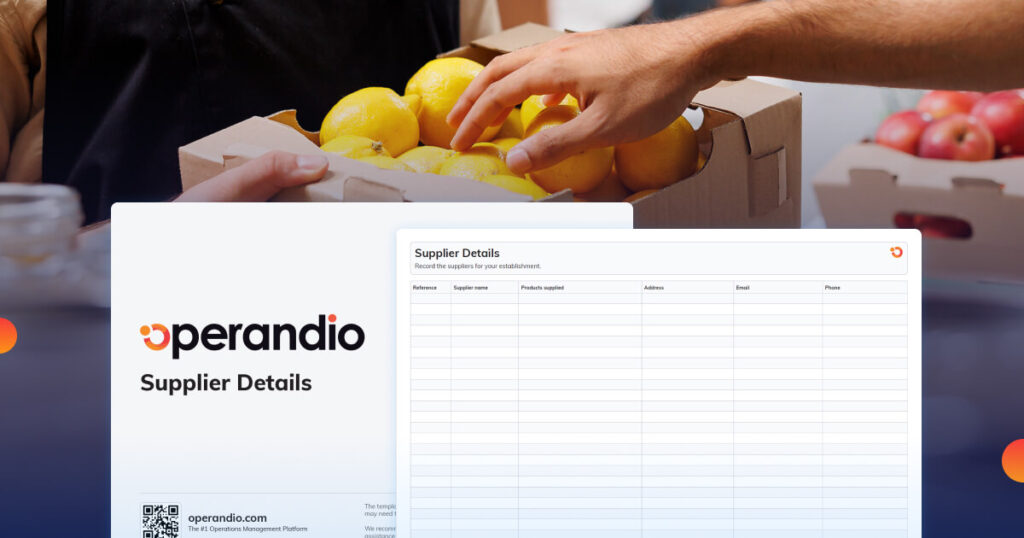If you’d like to take things a step further by digitizing your restaurant or franchise operations, you can book a demo to get custom pricing for Operandio.
Ultimate Food Safety Record templates resource
The ultimate Food Safety Record template resource

In industries like food service, hospitality and healthcare, ensuring food safety is critical. Having the right templates to monitor and document your processes can make all the difference in adhering to compliance, safeguarding your customers, and optimizing operations. Below, we provide an overview of essential Food Safety Records and where they fit into your food safety management plan. Each section includes a downloadable PDF to help you implement these practices effectively.
1. Allergen Matrix Form
What is an Allergen Matrix Form?
An allergen matrix is a document that lists menu items alongside allergens they may contain or encounter through cross-contamination. It’s essential for restaurants managing dietary requirements and protecting customers with food allergies.
Why is it important?
- Helps comply with allergen labeling laws.
- Ensures team members can confidently inform customers about allergens in menu items.
- Reduces the risk of allergic reactions and improves customer trust.
2. Cleaning Back of House template (daily, weekly, monthly)
What is a Back of House Cleaning template?
This template provides structured cleaning schedules for areas where food preparation and storage occur. It helps keep your kitchen spotless and compliant with food safety regulations.
Why is it important?
- Ensures regular and thorough cleaning of high-risk areas.
- Reduces contamination risk and maintains compliance.
- Breaks down tasks into manageable daily, weekly, and monthly schedules.

3. Cleaning Front of House template (daily, weekly, monthly)
What is a Front of House Cleaning template?
This form helps ensure the cleanliness of customer-facing areas, including tables, countertops, and shared spaces.
Why is it important?
- Creates a positive first impression for guests.
- Prevents cross-contamination between customer and service areas.
- Supports health inspection readiness.
4. Dishwasher Temperatures
What is a Dishwasher Temperatures template?
This document logs dishwasher cycle temperatures, ensuring dishes and utensils are sanitized properly.
Why is it important?
- Verifies that your dishwasher meets the required sanitization temperatures.
- Prevents the spread of bacteria and viruses.
- Maintains compliance with health regulations.
5. Cooling Temperatures Form
What is a Cooling Temperatures Form?
This form tracks the cooling process of food, ensuring items are stored safely within recommended time and temperature limits.
Why is it important?
- Prevents bacterial growth during cooling.
- Ensures compliance with food safety regulations.
- Protects customers from foodborne illnesses.
6. Incoming Goods Form
What is a Incoming Goods Form?
This form documents incoming shipments, including checks for temperature, condition, and compliance with supplier requirements.
Why is it important?
- Ensures raw materials meet quality and safety standards.
- Keeps records of supplier compliance for audits.
- Reduces waste and liability from substandard goods.

7. Storage Temperatures
What is a Storage Temperatures template?
This document tracks storage unit temperatures such as refrigerators, freezers, bain maries or hot boxes to ensure food stays fresh and safe.
Why is it important?
- Prevents spoilage by maintaining proper storage temperatures.
- Minimizes waste and maximizes product shelf life.
- Maintains compliance with food safety regulations.
8. Cold Holding Temperatures
What is a Cold Holding Temperatures Form?
This template monitors the temperature of cold holding units such as cold wells and chillers for ready-to-serve items like salads or desserts.
Why is it important?
- Ensures food stays within safe temperature ranges.
- Prevents spoilage and contamination.
- Helps pass health inspections with consistent documentation.
9. 2/4 Hour Log
What is a 2/4 Hour Log?
This form documents the time and temperature of ready-to-eat foods left unrefrigerated during preparation or service.
Why is it important?
- Ensures compliance with food safety regulations for time-sensitive foods.
- Helps avoid bacterial growth and contamination.
- Improves accountability during food prep.
10. Food Safety Incident Report
What is a Food Safety Incident Report?
This document tracks any food safety-related incidents where a guest has become unwell after dining at your establishment.
Why is it important?
- Provides documentation for internal reviews and audits.
- Identifies areas for improvement in your processes.
- Protects your business by showing a proactive approach to food safety.
11. Sous Vide Cooking Method
What is a Sous Vide Cooking Method template?
This form ensures that sous vide cooking processes for any vacuum-packed food, cooked into water bath or ovens follow time and temperature requirements for safety.
Why is it important?
- Guarantees safe preparation of sous vide items.
- Maintains consistency in cooking processes.
- Helps chefs adhere to food safety standards.

12. Supplier Details Form
What is a Supplier Details Form?
This template records supplier information, including contact details and products supplied.
Why is it important?
- Keeps an organized record of approved suppliers.
- Streamlines audits and supplier evaluations.
- Ensures your supply chain meets quality and safety standards.
Simplify food safety management
With these templates, you can ensure compliance, protect your customers, and maintain operational excellence. Download the forms you need to streamline your processes and elevate your food safety practices today.



